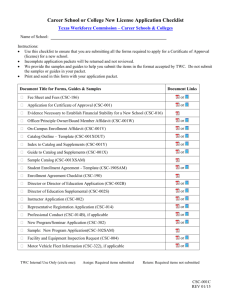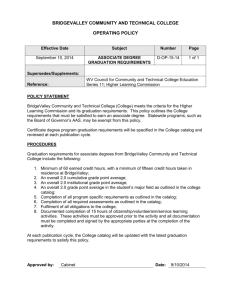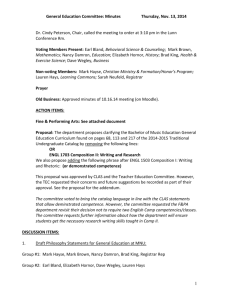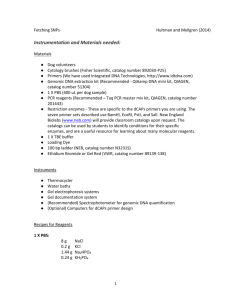Cee Courses Cataloge1
advertisement
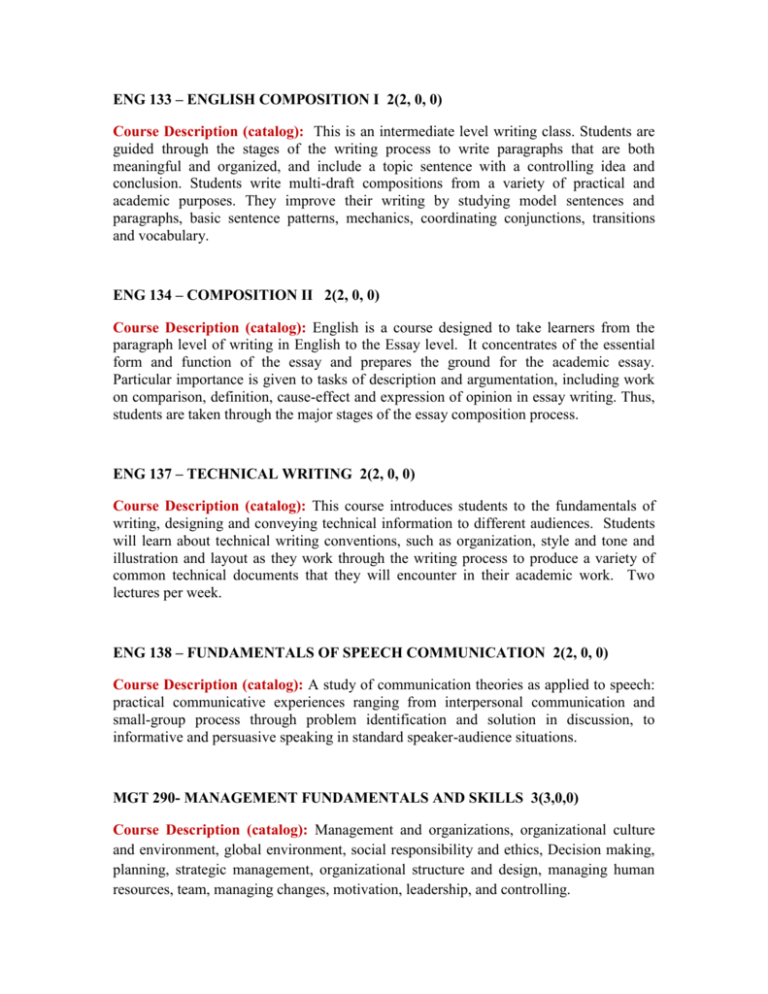
ENG 133 – ENGLISH COMPOSITION I 2(2, 0, 0) Course Description (catalog): This is an intermediate level writing class. Students are guided through the stages of the writing process to write paragraphs that are both meaningful and organized, and include a topic sentence with a controlling idea and conclusion. Students write multi-draft compositions from a variety of practical and academic purposes. They improve their writing by studying model sentences and paragraphs, basic sentence patterns, mechanics, coordinating conjunctions, transitions and vocabulary. ENG 134 – COMPOSITION II 2(2, 0, 0) Course Description (catalog): English is a course designed to take learners from the paragraph level of writing in English to the Essay level. It concentrates of the essential form and function of the essay and prepares the ground for the academic essay. Particular importance is given to tasks of description and argumentation, including work on comparison, definition, cause-effect and expression of opinion in essay writing. Thus, students are taken through the major stages of the essay composition process. ENG 137 – TECHNICAL WRITING 2(2, 0, 0) Course Description (catalog): This course introduces students to the fundamentals of writing, designing and conveying technical information to different audiences. Students will learn about technical writing conventions, such as organization, style and tone and illustration and layout as they work through the writing process to produce a variety of common technical documents that they will encounter in their academic work. Two lectures per week. ENG 138 – FUNDAMENTALS OF SPEECH COMMUNICATION 2(2, 0, 0) Course Description (catalog): A study of communication theories as applied to speech: practical communicative experiences ranging from interpersonal communication and small-group process through problem identification and solution in discussion, to informative and persuasive speaking in standard speaker-audience situations. MGT 290- MANAGEMENT FUNDAMENTALS AND SKILLS 3(3,0,0) Course Description (catalog): Management and organizations, organizational culture and environment, global environment, social responsibility and ethics, Decision making, planning, strategic management, organizational structure and design, managing human resources, team, managing changes, motivation, leadership, and controlling. DEIC 101- ISLAMIC CREED AND CONTEMPRARY DOCTRINES 2(2,0,0) Course Description (catalog): Creed: definition, importance, sources, characteristics, study methodology, pillars of faith, influence of creed on individuals and society, belief nullifiers, thought constraints, study of some contemporary doctrines: secularism, Satan worshipers, Baha'ism, Zionism, Misoneism, Christian fundamentalism. Student is required to memorize part of the holy Quran. DEIC 301- CONTEMPORARY CULTURAL ISSUES 2(2,0,0) Course Description (catalog): Moderation, Islam globalism and human ties, discrimination and nationalism, Arabic as the medium of education and culture, science and religion, interfaith dialogue, Orientalism and Christianization, Colonialism, Westernization, modernity in literature, Globalization, Terrorism, Development of Moslem nations. CS 204 – ENGINEERING PROGRAMMING 3(3, 0, 0) Course Description (catalog): Introduction to computer systems; problem solving methodology; testing and debugging of programs; variables, declarations, and assignments; input and output; data types; control flow and looping; functions and overloading; streams and input/output; one-dimensional arrays; two-dimensional arrays; pointers and dynamic arrays; structures; abstract data types and classes; inheritance; friends, overloaded operators, and arrays in classes; recursive functions. Three lectures per week. Projects that will require lab work will be assigned weekly. MGT 290 – MANAGEMENT FUNDAMENTALS AND SKILLS 3(3-0-0) Course Description (catalog): Management and organizations, organizational culture and environment, global environment, social responsibility and ethics, Decision making, planning, strategic management, organizational structure and design, managing human resources, team, managing changes, motivation, leadership, and controlling. MATH 144 – CALCULUS I 4(4,0,0) Course Description (catalog): Functions, Limits and Continuity, Differentiation, Applications of Derivatives, Integration. MATH 145 – CALCULUS II 4(4,0,0) Course Description (catalog): Techniques of Integration, Multiple Integration, Applications of Integration, Infinite Sequences and series (Power Series and Taylor Series), Polar coordinates, Transcendental Functions, Vectors, Vector Valued functions MATH 240 – DIFERENTAIL EQUATIONS 3(3,0,0) Course Description (catalog): Introduction to differential equations; solutions to first order differential equations; solutions to second and higher order linear differential equations; solutions to systems of differential equations; Laplace transform and applications to solving Differential equations. MATH 244 – MULTIVARIATE CALCULUS 3(3,0,0) Course Description (catalog): Solid analytic geometry, vector calculus, partial derivatives, and multiple integrals. MATH 246 – LINEAR ALGEBRA 3(3,0,0) Course Description (catalog): Linear transformations, finite dimensional vector spaces, matrices, determinants, systems of linear equations, and applications to areas such as linear programming. Markov chains and differential equations. PHYS 140 – GENERAL PHYSICS I 3(3,0,0) Course Description: The course is an introduction to units, measurements, motion in one and two dimensions, kinematics and dynamics, Newton's laws, work and energy, rotational dynamics, linear and angular momentum, torque, and collisions. Basic calculus and multi-variable algebra will be used. PHYS 141 – GENERAL PHYSICS II 3(3,0,0) Course Description: This course introduces students to the physics of electricity and magnetism and the connections between them. The concepts of electric charge, electric field, electric potential, Kirchhoff Law, Gauss Law, electric and magnetic fluxes, capacitance, resistivity and resistance, connections in series and in parallel, RC-circuit, magnetic field, magnetic force, magnetic and electric torques, Ampere Law, electromagnetic induction, and Faraday Law and Lenz Law will be taught. PHYS 144 – GENERAL PHYSICS I LAB 1(0,0,3) Course Description (catalog): Physics sequence lab experiments covering basic concepts of mechanics, Force, motion and Energy conservation, Measurement of basic constants: length, weight and time, Hooke’s law and elasticity. PHYS 145 – GENERAL PHYSICS II LAB 1(0,0,3) Course Description (catalog): Physics sequence lab experiments covering basic concepts of Electricity, magnetism, optics and optical instruments. CHEM 140- GENERAL CHEMISTRY I 3(3,0,0) Course Description (catalog): Matter properties and measurement, Atoms and the Atomic Theory, Chemical Compounds, Chemical Reactions, Reactions in Aqueous Solutions, Liquids Solids and Intermolecular Forces, Electrons in Atoms, Periodic Table and Atomic Properties, Chemical Bonding, Valence-Bond, Hybridization of Atomic Orbital, Multiple Covalent Bonds, Molecular Orbital Theory, Liquids and Solids. CHEM 142- GENERAL CHEMISTRY II 3(3,0,0) Course Description (catalog): Properties of Gases: Kinetic-molecular theory of gases, Ideal gas law, Mixtures of gases, Thermo- chemistry, Principles of Chemical Equilibrium, Acids and Bases, Buffer Solutions, Neutralization Reactions and Titration Curves, Solubility and Complex-Ion Equilibria, Spontaneous Change: Entropy and Free Energy, Thermodynamic, Solutions and Their Physical Properties, Chemical Kinetics and Electrochemistry. CHEM 143 – GENERAL CHEMISTRY LAB 1(0,0,3) Course Description (catalog): Laboratory safety rules and Evaluation of analytical data, Definition and determination of density, explanation and determination of specific heat, concept of Acids, bases and Heat of Neutralization Reaction and its determination, reversible reactions, concept of equilibrium constant and its determination, Le Chatelier principle and its verification, principle involved in Acid base titrations, indicators, Ionization of electrolytes, determination of dissociation constant of weak acid(Ka), principle involved in complexometric titrations, hardness of water and its determination. ENGR 100- INTRODUCTION TO ENGINEERING 1(1,0,0) Course Description (catalog): This course introduces engineering to students, particularly those who are interested in an engineering profession. It covers engineering ethics, teamwork, communication skills, engineering topics, and engineering problem solving skills and design methodology. ENGR 105- ENGINEERING COMPUTING & SKILLS 2(2,0,4) Course Description (catalog): Problem solving skills and computing using Matlab ENGR 106 – ENGINEERING GRAPHICS 2(2,0,4) Course Description (catalog): An introductory course in engineering graphics focuses on graphical communication. Topics include descriptive geometry elements, visualization, engineering drawing techniques, orthographic projection, pictorial representation, section views, and basic dimensioning. The course incorporates computer aided drafting (CAD) with engineering applications using 2-D drawing. This course is divided in to two sections: sketching and AutoCAD. The course begins by teaching the basics of engineering graphics using sketching. Freehand sketching using only a pencil and paper is an important skill for any engineer. It is a means of quickly conveying technical information to others. Through sketching the concepts of pictorial projections, section views, auxiliary views and dimensioning are taught. Once the foundation of engineering graphics is known, these concepts can be applied using computer aided design (CAD) software. AutoCAD is taught first. AutoCAD is a drawing software package used to create two dimensional engineering drawings. ENGR 201 – STATICS 3(3,0,0) Course Description (catalog): The subject of Statics deals with forces acting on rigid bodies at rest covering coplanar and non-coplanar forces, concurrent and non-concurrent forces, friction forces, hydrostatic forces, centroid and moments of inertia. Much time will be spent finding resultant forces for a variety of force systems, as well as analyzing forces acting on bodies to find the reacting forces supporting those bodies. This course also shows how to find the internal forces in structural elements and how the get the centriod and inertia for areas. Students will develop critical thinking skills necessary to formulate appropriate approaches to problem solutions. ENGR 203- DYNAMIC 3(3,0,0) Course Description (catalog): Fundamentals of particle and rigid body dynamics. Kinematics and kinetics of a single particle and system of particles. Application of Newton’s laws and energy and moment principles in solving problems involving particles or rigid bodies in planar motion. Introduction to kinetics of rigid bodies in three dimensions, angular acceleration, angular momentum, instantaneous centre, mechanical vibrations of simple spring-mass systems. ENGR 202- STRENGTH OF MATERIALS 3(3,0,0) Course Description (catalog): The course covers strength of materials in depth including the followings: Basic Concepts in Strength of Materials, Direct Stress, Strain, Axial Deformation and Thermal Stress, Torsion, Transverse Shearing Forces, Bending Moments in Beams and Stress Due to Bending, Shearing Stresses in Beams, Combined Stresses and Pressure Vessels, Stress Transformations, Deflection of Beams, Columns. ENGR 206- ELECTRIC CIRCUTES 3(3,0,0) Course Description (catalog): Resistors, capacitors, inductors, currents; voltages; power and energy; circuit analysis techniques; DC and AC analysis; magnetic circuits and transformers; Introduction to DC and AC machines. ENGR 209 – STREGTH OF MATERIALS LAB 1(1,0,3) Course Description (catalog): Strength of materials lab contains many equipments that can be utilized to introduce the most important concepts of materials and its ability to withstand external loads without failure which is the base of machine and components design. On the other hand strength of material lab will support student information in materials and its properties and strength of materials and types of loadings and types of stresses induced in members due to this loadings. The most important experiments in the field of strength of materials like tensile test, compression test, torsion test, Fatigue test, Hardness test, impact test, and creep test will be disscussed ENGR 307 – ENGINEERING ECONOMICS 3(3,0,0) Course Description (catalog): The course covers the following topics: Engineering Economic Decisions; Understanding Financial Statements; Cost Concepts and Behaviors; Time is Money; Understanding Money and Its Management; Principles of Investing; Present Worth Analysis; Annual Equivalent Worth Analysis; Rate of Return Analysis; Depreciation; Taxes; Break-Even Analysis, Cost Estimation; Developing Project Cash Flows; Inflation; Replacement Decisions. ENGR 309- FLUID MECHANICS 3(3,0,0) Course Description (catalog): The course addresses flow classification, fluid properties, fluid in statics, pressure measurements, buoyancy, fluids in motion, continuity equation, pressure gradient in fluid flow, Bernoulli’s, Reynold’s transport theorem, momentum and energy equations, dimensional analysis and similitude, and an introduction to the hydrodynamic boundary layer. ENGR 312 – FLUID MECHANICS LAB 1(0,0,3) Course Description (catalog): Conduct experiments to understand the basic concepts of fluid mechanics such as Hydrostatic Bench, Orifice and Jet Flow Apparatus, Bernoulli's Theorem Apparatus, Impact of Jet Apparatus, Piping Loss Test Panel, Open Circuit Wind Tunnel, Pump Test Set, Turbine Service Unit, Series/ Parallel Pumps, Variable Slope Channel. ENGR 310- NUMERICAL METHODS 3(3,0,0) Course Description (catalog): Introduction to Numerical Methods, Solution of Nonlinear Equations, Solution of Simultaneous Linear Algebraic Equations, Solution of Matrix Eigenvalue Problem, Curve Fitting and Interpolation, Numerical Differentiation, Numerical Integration, Ordinary Differential Equations: Initial-Value Problems, Ordinary Differential Equations: Boundary-Value Problems. ME 202 – THERMODYNAMICS I 3(3,0,0) Course Description (catalog): Thermodynamics concepts and definitions, states, properties, systems, control volume, processes, cycles, units, tables of properties, work and heat, first law, internal energy and enthalpy, conservation of mass, steady–state and uniform state processes, second law, reversible processes, entropy, Claudius inequality, principle of the increase of entropy, efficiencies, irreversibility and availability, power and refrigeration cycles. CEE 101 – GEOLOGY 3(3,0,0) Course Description (catalog): The course provides sufficient knowledge of qualitative and quantitative description of soils and rock masses with emphasis on the physical properties as well as the geological processes, e.g., weathering, erosion, plate tectonics, earthquakes, groundwater flow, land subsidence etc. On the other hand, the basic concepts of structural geology are focused to some extent by considering the basics of geological mapping. The course provides an introduction of engineering geology with the purpose of making an understanding that, how the geology influences the design and construction of engineering project. It also establishes a good understanding about the geological and geophysical techniques for site investigation process. CEE 272 – SURVEYING AND GPS 3(2,1,3) Course Description (catalog): An introduction to surveying, which includes surveying terminology, distance and area measurement, coordinate systems, surveying techniques, equipment use, theory of errors, tape measurements, leveling, theodolite, traverse surveying, topographic surveys, highway curves, control survey and land survey. Introduction to reference systems; types of GPS observable; basic principles of GPS operations; GPS error analysis; field procedures; data collection, processing; applications. Emphasis is placed on use of the hand compass and GPS receivers. Designing and conducting experiments as well as to analyze and interpret data through conducting several field experiments ranging from distance measurements to topographic mapping. CEE 281 – CONSTRUCTION MATERIALS LAB 1(0,0,3) Course Description (catalog): This course covers: introduction to testing and specifications, concrete and mortar tests, aggregate testing, fresh and hardened concrete testing, non-destructive tests, design & testing of concrete mixes. CEE 282 – CONSTRUCTION MATERIALS 3(3,0,0) Course Description (catalog): Introduction to structures and properties of civil engineering materials, such as asphalt, cements, concrete, geological materials, steel, polymers, and wood. The properties range from elastic, plastic and fracture properties to porosity and thermal and environmental responses. Laboratory tests include evaluation of behavior of these materials under a wide range of conditions. CEE 309 – INTRODUCTION TO PROBABILITY & STATISTICS 2(2,0,0) Course Description (catalog): This course provides an introduction to probability and statistics with applications. Topics include: basic probability models; combinations; random variables; discrete and continuous probability distributions and their functions; statistical estimation and testing; confidence intervals; and an introduction to linear regression and correlation. The main objective is to provide students with the foundations of statistical inference mostly used in business and economics. The course will emphasizes the manner in which probability yields insight into statistical problems; ultimately resulting in an intuitive understanding of the statistical procedures most often used by practicing engineers and scientists. Real data sets are incorporated in a wide variety of exercises and examples throughout the course, and this emphasis on data motivates the probability coverage. CEE 310- STRUCTURAL ANALYSIS 3(3,0,0) Course Description (catalog): This course covers basic principles and methods of structural analysis in depth including the followings: Types of structures - Structural elements and loadings - Difference between determinate and indeterminate structures – Stability in structures - Analysis of determinate structures to calculate reactions - Internal loadings - Shear force and Bending moment diagrams for beams and frames Application of principle of superposition in: calculation of reactions, shear and moments - Analysis of all types of plane and space trusses for internal forces - Influence line diagrams of determinate structures: qualitative and quantitative - Maximum and absolute maximum values of functions: reactions, shear and moment – Deformations: displacements and rotations due to all types of loadings - Calculation of deformations using: double integration method, moment-area theorems, conjugate-beam method, method of virtual work, and method of least work - Analysis of indeterminate structures using approximate methods of analysis - Analysis of indeterminate structures by method of consistent deformations - Applications of deflections and principle of superposition in force method - Cables and Arches. This course gives also a brief introduction of difference between analysis and design, and application of structural analysis in structural steel design and design of reinforced concrete structures according to the ACI-318-11 building code requirement. Students also participate in a group or individual project on analysis of real structures using hand calculations and verification by commercially available computer based software such as SAP2000. CEE 335- HYDROLOGY 3(3,0,0) Course Description (catalog): This course introduces students to the study of environmental hydrology and focuses on physical processes of water movement via precipitation, interception, evaporation, runoff, infiltration, groundwater flow, and stream flow. Emphasis is placed on measurement and analysis of these processes and on factors that influence the spatial and temporal distribution of water resources. Applied aspects of hydrology such as storm prediction, flow control structures, measurement instrumentation, and hydrologic design will also be discussed. CCE 340 – HIGHWAY ENGINEERING 3(3,0,0) Course Description (catalog): The course covers requirements engineering in depth including the followings: Introduction to Pavement, different types of pavements, materials used in pavement construction, traffic load analysis, load equivalency factor concept, tyre-pavement contact area concept, stress-strain analysis of flexible and rigid pavements, flexible pavement design, rigid pavement design, highway maintenance and rehabilitation, flexible pavement distresses and their repair techniques, highway drainage facility, design of HMA using Marshal method and Superpave Volumetric design systems. CEE 345 – CONSTRUCTION MANAGEMENT 3(3,0,0) Course Description (catalog): The course covers construction management in depth including the followings: Basic concepts – Construction versus manufacturing processesConstruction industry and its structure – Bid package – Prequalification – The estimate and decision to bid – Bonds - Award of contract – Contract agreement – Time extension – Change orders – Liquidated damages – Progress payments – Acceptance and Final Payment - Construction contract types – Comparing project delivery methods – Legal structure of organizations – Developing the work breakdown structure (WBS) – Work packages – Cost control related to WBS – Estimating activity duration – Bar charts – Activity precedence diagrams – Critical path method –Activity floats – Relationship scheduling computations – Program evaluation and review techniques (PERT) network – Linear construction operations – Production curves – Cash flow projection – Cash flow to the contractor – Project funding – Construction financing process – Cost control as a management tool – Project cost control systems – Cost accounts – Cost coding systems – Material management process – Material types - The order – Approval process – Need for Safe practices - Humanitarian concerns – Economic benefits – safety management system will be discussed. CEE 350- ENVIRONMENTAL ENGINEERING 3(2,0,3) Course Description (catalog): This course is designed to introduce the student to the principles of environmental engineering. Topics include environmental chemistry, materials and energy balances, water quality management, water treatment, wastewater treatment, and air pollution. Weekly experiments carried out through the course, include water quality measurements such as dissolve oxygen measurement, pH and EC measurement, total solid measurement determination of biological oxygen demand (BOD), chemical oxygen demand (COD), total organic carbon (TOC), nitrogen, phosphorus, hardness, turbidity, alkalinity, etc. CEE 360 – GEOTECHNICAL ENGINEERING 3(3,0,0) Course Description (catalog): Geology and origin of geomaterials, index and classification of soils, clay minerals and soil structure, water flow in soils (one and two dimensional water flow), geotextile filter design, soil stresses, compaction and stabilizing of soils, distribution of stresses in soil due to external loads, consolidation and consolidation settlement, shear strength of soils, stability of slope. CEE 361 – GEOTECHNICAL ENGINEERING LAB 1(0,0,3) Course Description (catalog): Perform tests for soil samples in the following properties Index and classification of soil, soil stresses, soil compaction, consolidation and consolidation settlement, shear strength of soils. The course was provide laboratory and field practice to the civil engineering students on performing some of soil mechanics tests that are necessary to classify, stabilize, and obtain the engineering properties of soil. Water content determination, liquid and plastic limit, shrinkage limit, grain size distribution (sieve analysis), hydrometer analysis, compaction, in-situ field density, constant and falling head permeability tests, unconfined compression test, and direct shear test. CEE 390– CIVIL ENGINEERING DRAWINGS 1(0,0,3) Course Description (catalog): This course is designed to provide civil engineering undergraduates with basic understanding of the theory and practice of engineering drawings and computer-aided design for civil engineering applications. Students will learn to read and construct blueprints and working drawings by means of lectures, discussion of drawing examples related to existing buildings or projects, CAD practice. Topics will include basic fundamentals of graphics and drafting principles, Auto-Cad fundamentals, architectural drawings, structural floor plan of building, detailing for typical reinforced concrete structural members. CEE 410 – ADVANCE STRUCTURAL ANALYSIS 3(3,0,0) Course Description (catalog): This course covers advanced methods of structural analysis for indeterminate structures in depth including the followings: Theory and application of structural analysis - Advantages and disadvantages of indeterminate structures - Degree of indeterminacy - Equilibrium and compatibility - Stiffness (slopedeflection) and flexibility methods (force) of analysis - Application of deflection methods in force method - Influence lines (qualitative and quantitative) for indeterminate structures: beams, frames, and trusses - Approximate methods of analysis - Moment distribution method: beams and frames with and without sway having vertical and sloping legs, Method of successive corrections: multi-storey frames having side-sway Matrix method of analysis (computer methods) with emphasis on the direct stiffness method - Use of computer programs in structural analysis - Modeling of two- and threedimensional structures - Verification and interpretation of structural response. This course gives also a brief introduction of application of structural analysis in structural steel design and design of reinforced concrete structures according to the ACI-318-11 building code requirement. Students also participate in a group or individual project on analysis of real structures (indeterminate) using hand calculations and verification by commercially available computer based software such as SAP2000. CEE 427- FOUNDATION ENGINEERING 3(3,0,0) Course Description (catalog): Introduction, Soil mechanics review, Site investigation & subsurface exploration, Bearing capacity of shallow foundation & Foundation design, distribution of stresses in soils, Mat foundations, Settlement of shallow foundation, Foundation on rock, Pile foundations & group piles, Lateral earth pressure and earth retaining structures, Sheet pile walls, Braced excavations. CEE 451- WATER SUPPLY AND WASTEWATER TREATMENT 3(3,0,0) Catalogue Description (CATALOG): Water quality criteria and fundamentals of acceptability. Technologies for water purification of surface waters. Processes employed in the treatment of water and wastewater. CEE 470 – CONTRACTS AND SPECIFICATION 2(2,0,0) Course Description (catalog): The course covers contracts and specifications in depth including the followings: Project delivery methods - importance of contract management – how contracts and specifications are used in the engineering and construction industry – Ethics and morals – Role of engineering professional societies in ethics – Profession code of ethics – Enforcing engineering code of ethics – Whistle-blowing in the engineering profession - Forming engineering and construction contracts – Contract administration models – Engineering contracts - Construction contracts – Construction bid proposals – Components of construction contracts – Components of engineering contracts – Duties and responsibilities of the Architect / Engineer – Topics covered or avoided in construction contracts – Construction contract clauses requiring interpretation – Performance and Breach of contract – Ways to terminate contracts – Definition and types of specifications, Standard specifications – Technical standards – Government contracting – Bonding requirements – Types of bonds – Government construction contracts – Stop notices – Change orders – Addenda – Construction claims – Documentation to support claims – Construction delay claims – Utilizing CPM for delay analysis – Quantification of contractor delay claims – Owner damages for delay – Minimizing delay claims – Contract negotiations – Contract mediation – Arbitration – Litigation – Dispute review boards – International contracts and arbitration will be discussed. CEE 472 – APPLICATIONS OF GIS IN CIVIL ENGINEERING 3(3,0,0) Course Description (catalog): This course covers fundamental concepts underlying computerized geographic information systems (GIS) at an introductory and intermediate level, and its applications for Civil Engineering. It combines an overview of the general principles of GIS with a theoretical view of and analytical use of spatial information. The practical component of the course gives students hands-on experience with the latest ArcGIS software and focuses on data modeling, and management, and creating solutions to problems in civil engineering applications; usually three to five problem-solving tasks will be assigned at the end of each lecture. CEE 495 – SENIOR DESIGN-1 2(2,0,0) Course Description (catalog): This is the first phase of the senior design project that is a continual project comprise of two semesters. It involves a group of students, where numbers of students in the group are selected based on the type of the assigned project. Students are required to work as a team tackling different aspects of the civil engineering works in an efficient manner. This phase mainly introduces policies, identifying problems, statement formulation, knowledge of ethical responsibilities, and conceptual design. It also includes project selection, conceptual design evaluation, data collection, identification of real-life constraints (e.g. economy, environmental, global, and contemporary issues), generation of possible design alternatives considering client needs, selection of the preferred alternative, and preparation of a work plan for implementing and completing the project. All work conducted during the semester must be compiled in a final report and orally presented to the examining committee which is comprised of project advisor, departmental faculty and senior design coordinator. CEE 496- SENIOR DESIGN II 2(2,0,0) Course Description (catalog): This is the second and final phase of the senior design project, where students are required to implement their plan, devised at senior design-I level. It includes designing a system, component, or process to meet set objectives. Students mainly carry out design calculations and use of experimental tools to design, and or do data analysis for the preferred alternative. The final report to be submitted by the team includes project title, description, objectives and constraints, data and assumption; design alternatives and analyses, details of preferred design along with pertinent drawings, abstract, conclusions and recommendations. In addition, the student team should orally present the project to the examining committee.

